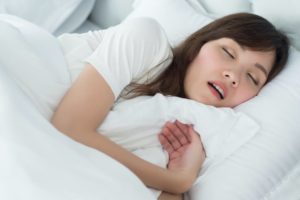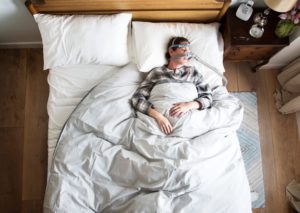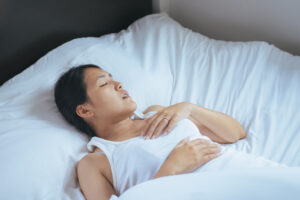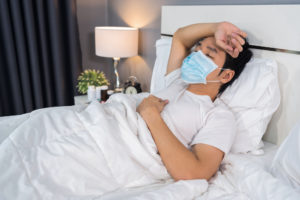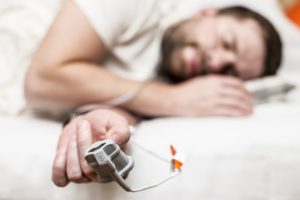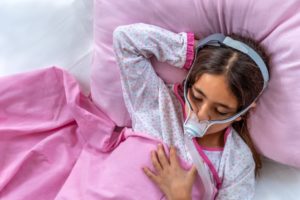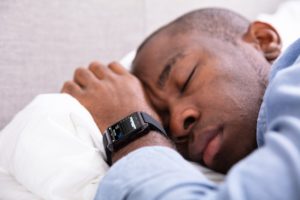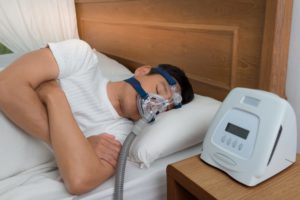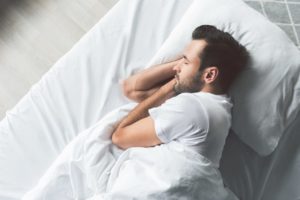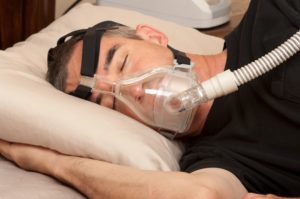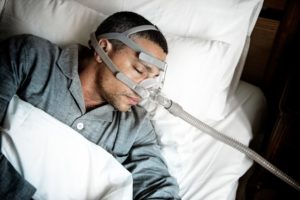Is It Snoring or Is It Sleep Apnea?
While almost everyone snores on occasion, persistent snoring may be a sign of obstructive sleep apnea, a common breathing condition that affects around 30 million people in the United States. Distinguishing between snoring and obstructive sleep apnea is essential because, if left untreated, sleep apnea can have long-term effects on a person’s health and quality of life.
Common Causes of Snoring
As a person drifts into sleep, a variety of changes happen in the body that affect breathing. Muscles in the head and neck naturally relax, the airway narrows, and a sleeper no longer consciously controls their breathing. Normally these natural changes don’t cause problems. Sometimes though, the airway can become too narrow and cause snoring or obstructive sleep apnea.
Snoring occurs when the airway is narrow enough that tissues flutter against each other during breathing. Numerous factors can contribute to airway narrowing and increase the risk of snoring. These include:
- Being over 50 years old
- Sleeping on the back
- Having certain physical features
- Obesity
- Nasal congestion or inflammation in the airway
- Pregnancy
- Certain medications
- Alcohol and tobacco
Many of these same factors increase the risk of developing obstructive sleep apnea. Obstructive sleep apnea occurs when the airway narrows so much that it becomes prone to collapsing or becoming blocked during the night.
Is Your Snoring a Health Risk?
Answer three questions to take charge of troubled sleep.
Is Your Snoring a Symptom of Sleep Apnea?
Snoring is a symptom that may or may not be observed by the affected individual or their bedparter. While loud and persistent snoring is often associated with obstructive sleep apnea, not everyone with OSA snores loudly or continuously . In adults, other signs and symptoms of obstructive sleep apnea may include:
- Pauses in breathing during sleep
- Feeling sleepy during the day or falling asleep during activities
- Gasping or choking when waking up
- Recurrent morning headaches
Symptoms of obstructive sleep apnea often appear differently in children . In addition to persistent nighttime snoring, children may exhibit oppositional or challenging behaviors, have asthma that is difficult to control, or develop high blood pressure.
“The presence of snoring deserves to be looked into since it could be a red flag of obstructive sleep apnea (OSA). Many treatments are available for both snoring and OSA, and determining what you are dealing with is the first step to ensuring your long-term health and well-being are protected.”
Dr. Audrey Wells, Sleep Physician, CPAP Expert
Will Treating Sleep Apnea Reduce Snoring?
For people diagnosed with obstructive sleep apnea, treatment for nighttime breathing problems should reduce or eliminate snoring . The most common treatment for obstructive sleep apnea is positive airway pressure (PAP) delivered through a CPAP machine or similar device. A CPAP machine typically eliminates both snoring and obstructive sleep apnea by using air pressure to keep the airway open during sleep.
Research shows that other treatments for obstructive sleep apnea can also reduce snoring, including the use of an oral appliance, surgery, and lifestyle changes like changing medications and reducing alcohol consumption.

When to See a Doctor
Anyone concerned about snoring or sleep apnea should speak with a doctor, especially if snoring is accompanied by pauses in breathing during sleep or daytime tiredness. It is also important to contact a doctor if snoring occurs alongside weight gain or changes in thinking or memory.
Many people are unaware of changes in their breathing during sleep. For this reason, it may be helpful to ask bed partners, roommates, and others if they have noticed loud snoring or other symptoms of obstructive sleep apnea.
Doctors can assess snoring and other symptoms, prescribe tests to diagnose sleep apnea, and recommend appropriate treatment.

Still have questions? Ask our community!
Join our Sleep Care Community — a trusted hub of sleep health professionals, product specialists, and people just like you. Whether you need expert sleep advice for your insomnia or you’re searching for the perfect mattress, we’ve got you covered. Get personalized guidance from the experts who know sleep best.
References
7 Sources
-
Badr, M. (2023 September). Pathophysiology of upper airway obstruction in obstructive sleep apnea in adults. In N. Collup & G. Finlay (Ed.). UpToDate., Retrieved September 23, 2023, from
https://www.uptodate.com/contents/pathophysiology-of-upper-airway-obstruction-in-obstructive-sleep-apnea-in-adults -
Schwab, R. J. (2022, May). Snoring. Merck Manual Consumer Version., Retrieved September 23, 2023, from
https://www.merckmanuals.com/home/brain,-spinal-cord,-and-nerve-disorders/sleep-disorders/snoring -
A.D.A.M. Medical Encyclopedia. (2023, July 8). Snoring – adults. MedlinePlus., Retrieved September 23, 2023, from
https://medlineplus.gov/ency/patientinstructions/000720.htm -
A.D.A.M. Medical Encyclopedia. (2023, January 9). Obstructive sleep apnea – adults. MedlinePlus., Retrieved September 23, 2023, from
https://medlineplus.gov/ency/article/000811.htm -
Paruthi, S. (2023, October 13). Evaluation of suspected obstructive sleep apnea in children. In R. Chervin & A. Hoppin (Ed.). UpToDate., Retrieved October 23, 2023, from
https://www.uptodate.com/contents/evaluation-of-suspected-obstructive-sleep-apnea-in-children -
Wise, M. & Tapia, I. (2023, September 13). Assessment of sleep disorders in children. In R. Chervin & A. Hoppin (Ed.). UpToDate., Retrieved September 23, 2023, from
https://www.uptodate.com/contents/assessment-of-sleep-disorders-in-children -
Brown, L. & Lee, W. (2023 September). Titration of positive airway pressure therapy for adults with obstructive sleep apnea. In N. Collup & G. Finley (Ed.). UpToDate., Retrieved September 23, 2023, from
https://www.uptodate.com/contents/titration-of-positive-airway-pressure-therapy-for-adults-with-obstructive-sleep-apnea





